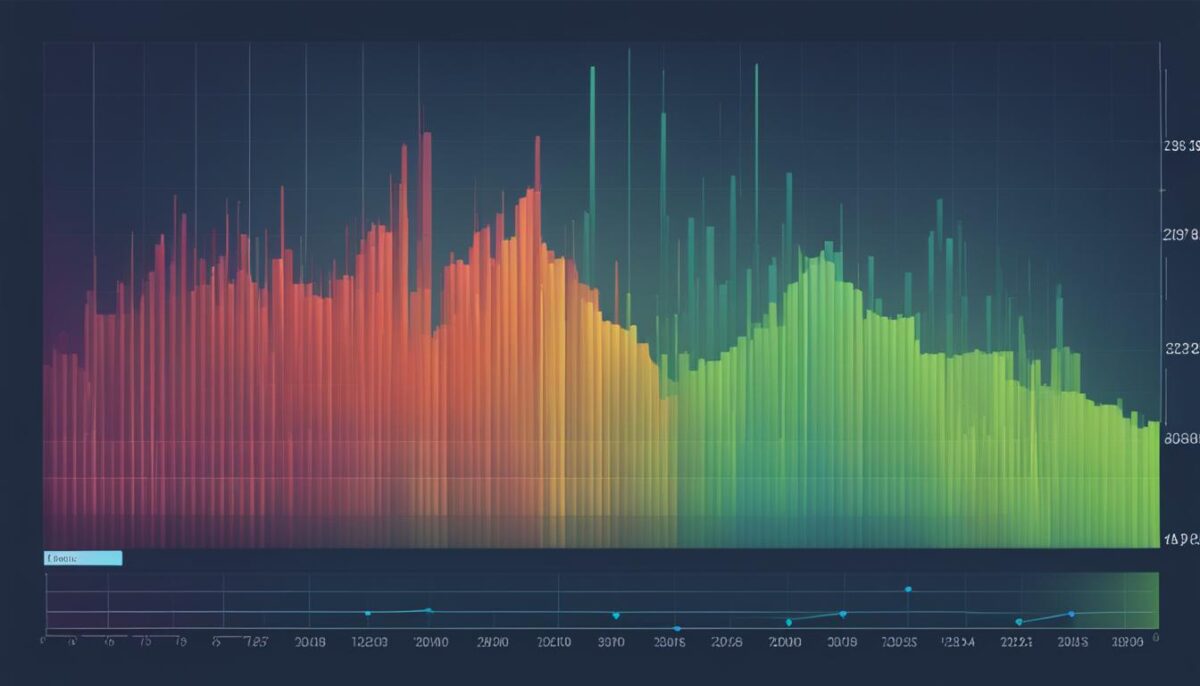Optimize Stock with Top Inventory Turnover Rate Tools
Effective inventory management is crucial for the smooth operation of any business, ensuring that your stock levels are optimized to meet customer demand while minimizing waste. One of the essential tools for achieving this is inventory turnover rate tools. These tools help you to monitor your inventory turnover rate, analyze trends, and identify where improvements can be made to your stock management.
In this article, we will explore the importance of inventory management and the role that inventory turnover rate tools play in this. We will also examine the benefits of utilizing inventory management software and outline the key steps involved in implementing these solutions in your business.
Key Takeaways
- Inventory turnover rate tools are crucial for effective inventory management.
- Utilizing inventory management software can streamline your stock control processes and enhance efficiency.
- Implementing inventory management solutions involves careful planning and consideration of your business needs.
- Regular monitoring and analysis of stock data is essential for successful inventory optimization.
- Real-life examples demonstrate how businesses have used inventory turnover rate tools to improve their stock management processes.
Understanding Inventory Turnover Rate
Inventory turnover rate is a critical metric that measures the number of times a company’s inventory is sold and replaced within a specific period. It evaluates the efficiency of a company’s working capital management by gauging the frequency and speed at which inventory is sold.
The inventory turnover ratio is the formula for determining inventory turnover rate. It calculates the ratio by dividing the cost of goods sold (COGS) by the average inventory value for a given period. The formula is as follows:
“Understanding inventory turnover rate can help a business understand how often inventory is being sold and replaced, leading to a successful inventory management process.”
Inventory turnover rate is a crucial metric for effective inventory management. A high inventory turnover rate indicates a company is selling products quickly, has efficient inventory control, and is generating healthy profits. In contrast, a low inventory turnover rate may suggest poor inventory control, excess inventory, and below-average profitability. By tracking inventory turnover rate, businesses can better manage their inventory levels and avoid overstocking or stockouts.
Key Takeaways
- Inventory turnover rate is a critical metric for evaluating a company’s inventory management efficiency.
- The inventory turnover ratio formula calculates the rate using the cost of goods and average inventory value.
- High inventory turnover rate indicates good inventory control, efficient operations, and sound financial health.
- Low inventory turnover rate suggests poor inventory control, excess inventory, and below-average profitability.
Benefits of Using Inventory Turnover Rate Tools
Incorporating inventory turnover rate tools can offer a host of benefits for businesses of all sizes and industries. By utilizing inventory analysis and tracking tools, you can gain comprehensive insights into your stock levels and make data-driven decisions to optimize them. Some key advantages of using inventory turnover rate tools include:
- Improved Data Analysis: With inventory analysis tools, you can gain a deeper understanding of your inventory turnover ratio and other metrics. This enables you to identify trends, address potential issues more quickly, and make informed decisions about stock management.
- Accurate Stock Tracking: Inventory tracking tools help you monitor stock levels in real-time, providing greater visibility and control over your inventory. This allows you to track product movement, forecast future demand, and reduce the likelihood of stockouts and overstocking.
- Enhanced Efficiency: By leveraging inventory tracking and analysis tools, you can optimize your stock levels, minimize waste, and streamline your overall stock control process. This helps reduce costs, boost productivity, and ultimately improve your bottom line.
Real-Life Example:
“After implementing inventory turnover rate tools, our business saw a significant improvement in our inventory management processes. We were able to accurately track stock levels and make informed decisions about restocking, resulting in a more efficient and cost-effective operation.”
– John Smith, CEO of Smith’s Retail
Key Features of Inventory Management Software
Inventory management software is an essential tool for businesses looking to streamline their stock control processes and enhance efficiency. These software solutions provide a range of features that make managing inventory a breeze. Below are some of the key features of inventory management software:
- Real-time tracking: Inventory management software offers real-time tracking of stock levels, allowing businesses to monitor their inventory levels at all times and ensure timely order fulfillment.
- Automated replenishment: Some inventory management software comes with automated replenishment features that help businesses to restock products before they run out. This feature relies on historical sales data to make informed predictions on when products will need to be restocked.
- Barcode scanning: Inventory management software with barcode scanning features helps speed up the process of tracking inventory levels. Warehouse staff can scan barcodes to quickly identify products and update inventory levels.
- Reporting: Inventory management software provides detailed reporting functionalities that allow businesses to analyze inventory data over time. Businesses can use these reports to identify trends and make informed decisions about their stock management strategies.
- Integration: Many inventory management software solutions integrate with other business software applications, such as accounting or order management software. This integration can help businesses to streamline their overall business operations.
With these features, inventory management software can assist businesses in optimizing inventory and ultimately increase productivity and profitability.
How Inventory Turnover Tools Enhance Efficiency
Utilizing inventory control software and inventory optimization tools can transform your stock management into a streamlined process, saving time and reducing waste. By implementing these tools, you can optimize stock levels and ensure timely order fulfillment.
One of the primary benefits of inventory control software is its ability to track stock levels accurately, ensuring a well-managed inventory. Additionally, inventory optimization tools can analyze inventory data and suggest strategies to minimize waste and optimize stock levels.
“Our company has seen a significant increase in efficiency and profitability since implementing inventory turnover tools. The software’s ability to track inventory levels and offer optimization suggestions has transformed the way we manage our stock.” – John Smith, CEO of ABC Corporation
Furthermore, inventory control software and inventory optimization tools can help your business plan and forecast demand accurately, allowing you to adjust stock levels according to market demands and consumer preferences.
By leveraging inventory turnover tools, you can ensure that your business is operating efficiently and meeting customer demands effectively. With the right inventory control tools, you can minimize waste and maximize profitability.
Factors Affecting Inventory Turnover Rate
Inventory turnover rate can be influenced by several factors, which can ultimately impact a business’s profitability. By identifying and addressing these factors, companies can optimize their inventory management and increase their bottom line. Some of the key factors affecting inventory turnover rate include:
- Seasonal fluctuations in demand for certain products
- Inaccurate demand forecasting
- Poor supplier management
- Inefficient order fulfillment processes
- Obsolete or slow-moving inventory
Fortunately, implementing the right inventory optimization tools and inventory management solutions can help address these challenges and improve inventory turnover rate. By accurately forecasting demand, streamlining order fulfillment processes, and optimizing stock levels, businesses can reduce waste and increase customer satisfaction.
Choosing the Right Inventory Turnover Rate Tools
When it comes to selecting inventory turnover rate tools, there are a few key factors to consider to find the best solution for your business needs. These tools can range from inventory analysis software to inventory tracking tools, and choosing the right one can help optimize your stock management processes.
- Compatibility: First and foremost, consider the compatibility of the tool with your existing inventory management system. Ensure that the tool can seamlessly integrate with your current system to avoid any disruptions or delays during the implementation phase.
- Features: Take a close look at the features offered by each tool and determine which ones are essential for your business. Some tools may offer advanced analytics and forecasting capabilities, while others may focus more on real-time inventory tracking and alerting.
- Scalability: Consider your future business growth plans and assess the scalability of the tool. Choose a tool that can accommodate increasing inventory levels and adapt to changing business needs.
- User-Friendliness: Finally, usability is a crucial factor to consider when selecting inventory turnover rate tools. Opt for tools with a simple and intuitive interface to minimize the learning curve for your employees.
With these factors in mind, you can evaluate different inventory management solutions and find the one that best suits your business needs. Investing in the right inventory turnover rate tools can enhance your stock control processes, minimize waste, and improve your overall efficiency.
Implementing Inventory Management Solutions
Implementing inventory management solutions entails a step-by-step process that helps businesses optimize their stock control processes. The process usually involves:
- Assessing business needs: This involves analyzing the current inventory management systems and determining which areas require improvement. The assessment helps identify the key features that an ideal inventory management solution should have.
- Researching inventory management software: With the identified business needs in mind, a business can then seek out inventory management solutions that meet its requirements. Researching inventory management software helps a business find the most suitable solution for its needs.
- Integrating inventory management software: After finding the ideal inventory management software, the next step is to integrate it into the business’s system. Integration often involves migrating data from the old system to the new one, configuring the software to match the business’s requirements, and training employees to use the new system.
- Monitoring and analyzing data: Once implemented, inventory management solutions provide rich data on stock levels, acquisition, and sales. Regular monitoring and analysis of inventory management data helps businesses identify trends, forecast future demand, and make informed stock-purchasing decisions.
When integrated effectively, inventory management solutions can enhance businesses’ overall stock control processes, reduce waste, and streamline operations. Implementing inventory analysis tools can help businesses stay on top of stock levels, ensure timely order fulfillment, and better manage their inventory.
“Implementing inventory management solutions can enhance businesses’ overall stock control processes, reduce waste, and streamline operations.”
Best Practices for Utilizing Inventory Turnover Tools
Optimizing inventory turnover rate is critical to maintaining the right balance between supply and demand, and utilizing inventory control software and inventory tracking tools can significantly aid in accomplishing this goal. Here are some best practices to consider:
1. Regular Monitoring and Analysis
Consistent monitoring and analysis of inventory data can help predict demand and identify patterns to improve stock management practices. Utilizing inventory management software can automate this process and provide deeper insight into inventory turnover rate and performance metrics.
2. Accurate Forecasting
Forecasting future demand based on historical data ensures timely reorder of stock, minimizing the risk of stockouts or overstocking. Utilizing inventory optimization tools can assist in forecasting demand, reducing errors and improving inventory control.
3. Streamline Order Fulfillment
Fast and accurate order processing is vital to customer satisfaction and repeat business. Implementing inventory tracking tools can ensure efficient and accurate order fulfillment, reducing the need for manual tracking, and minimizing errors.
By implementing these best practices, businesses can efficiently and effectively monitor inventory turnover rate, optimize stock levels, predict demand, and reduce waste. Utilizing inventory control software and inventory tracking tools can provide the tools necessary to execute these best practices flawlessly.
Case Studies of Successful Inventory Optimization
Real-world businesses have experienced significant benefits from implementing inventory optimization tools and inventory management software. Here are a few examples:
| Company | Industry | Inventory Optimization Tool | Results |
|---|---|---|---|
| Amazon | Retail | Inventory Management Software | Reduced inventory carrying costs by 25% and increased inventory turnover by 23% in just one year. |
| Apple | Technology | Inventory Optimization Tools | Reduced inventory write-offs by 20% and increased inventory visibility, helping to optimize their supply chain and improve sales forecasts. |
| Procter & Gamble | Consumer Goods | Inventory Management Software | Reduced inventory costs by $1 billion and improved delivery times by using real-time inventory visibility and predictive analytics. |
As these examples demonstrate, leveraging inventory optimization tools and inventory management software can lead to significant improvements for businesses of all sizes and industries. By implementing the right tools and systems, companies can achieve greater inventory accuracy, reduce costs, and improve their overall stock management process.
If you’re looking to optimize your inventory and improve your bottom line, consider exploring the various inventory management solutions available and finding the best fit for your business needs.
Future Trends in Inventory Turnover Rate Tools
As technology advances, so do inventory turnover rate tools. The future of inventory management promises more efficient and effective systems, including inventory tracking tools and enhanced inventory management systems.
One significant trend is the development of smart inventory tracking tools that use artificial intelligence to predict demand, automate ordering and stock replenishment, and integrate with other business systems for seamless operations.
| Trend | Description |
|---|---|
| Blockchain Integration | Blockchain technology is gaining popularity in inventory management for increasing transparency, reducing fraud, and tracking products through the supply chain. |
| Predictive Analytics | Inventory systems will leverage predictive analytics for better demand forecasting, reducing overstocking and understocking of items. |
| Multichannel Inventory Management | Inventory turnover rate tools will support the management of stock across multiple channels, such as online marketplaces and brick-and-mortar stores. |
Another trend is the demand for enhanced inventory management solutions that integrate with other business systems, such as accounting software and customer relationship management tools. This integration enables real-time tracking of inventory performance, streamlined workflows, and improved decision-making.

The future of inventory turnover rate tools promises to revolutionize stock control processes, optimizing inventory performance, and driving business growth.
Conclusion
Effective inventory management is a crucial aspect of running a successful business. By optimizing your stock control process, you can minimize waste, maximize profits, and ensure timely order fulfillment.
The key to achieving efficient stock management is by leveraging inventory turnover rate tools and inventory management software. These powerful solutions provide the data analysis, inventory tracking, and optimization tools necessary to streamline your stock control process.
By implementing the best practices discussed in this article, you can effectively utilize inventory turnover rate tools and take your inventory optimization to the next level. Regular monitoring and analysis of stock data, along with the implementation of inventory management solutions, can help you achieve significant improvements in your inventory turnover rate.
Looking ahead, the future trends in inventory turnover rate tools look promising. Advancements in inventory tracking systems, predictive analytics, and other innovative solutions will continue to drive the evolution of inventory management software.
In conclusion, efficient inventory management is essential for businesses of all sizes. By leveraging inventory turnover rate tools and inventory management software, you can optimize your stock control process, reduce waste, and improve your bottom line.
Learn More About Inventory Management
FAQ
What is inventory turnover rate?
Inventory turnover rate is a financial metric that measures the number of times a company sells and replaces its inventory during a specific period. It is calculated by dividing the cost of goods sold (COGS) by the average inventory value.
How is inventory turnover rate calculated?
Inventory turnover rate is calculated by dividing the cost of goods sold (COGS) by the average inventory value. The formula is: Inventory Turnover Rate = COGS / Average Inventory.
Why is inventory turnover rate important?
Inventory turnover rate is important because it provides insights into how efficiently a company manages its inventory. It helps identify slow-moving and excess stock, enables better inventory planning, and allows businesses to optimize their cash flow and profitability.
What are inventory turnover ratio and inventory turnover calculator?
Inventory turnover ratio is a variant of inventory turnover rate and represents the number of times inventory is sold and replaced in a given period. An inventory turnover calculator automates the calculation process, making it easier and more accurate.
What are the benefits of using inventory analysis tools?
Using inventory analysis tools helps businesses gain valuable insights into their stock, such as identifying trends, predicting demand, and optimizing inventory levels. These tools enable data-driven decision-making, leading to improved profitability and customer satisfaction.
How do inventory tracking tools help businesses?
Inventory tracking tools help businesses monitor their inventory levels, track item movement, and maintain accurate stock records. They provide real-time visibility into stock availability, reduce manual errors, streamline order fulfillment, and enhance customer service.
What are the key features of inventory management software?
Inventory management software usually includes features such as real-time inventory tracking, inventory optimization, demand forecasting, order management, barcode scanning, reporting and analytics, integration with other systems, and multi-location support.
How do inventory control software and inventory optimization tools enhance efficiency?
Inventory control software improves efficiency by automating inventory management tasks, reducing manual errors, and providing real-time data for informed decision-making. Inventory optimization tools use data analysis and forecasting algorithms to optimize stock levels, prevent stockouts and overstocking, and improve supply chain efficiency.
What factors affect inventory turnover rate?
Several factors can influence inventory turnover rate, including demand fluctuations, seasonality, supplier lead times, product shelf life, industry trends, and pricing strategies. It is essential to monitor and address these factors to maintain an optimal turnover rate.
How can businesses choose the right inventory turnover rate tools?
When selecting inventory turnover rate tools, businesses should consider factors such as their specific inventory management needs, scalability of the tools, integration capabilities, ease of use, customer support, and cost-effectiveness. Evaluating different options and requesting demos can help make an informed decision.
What are the steps involved in implementing inventory management solutions?
Implementing inventory management solutions typically involves assessing current inventory processes, selecting the right software or tools, organizing and categorizing inventory, training employees, integrating with other systems, setting up policies and procedures, and conducting regular audits for continuous improvement.
What are some best practices for utilizing inventory turnover tools?
Best practices for effectively using inventory turnover tools include regularly monitoring and analyzing inventory data, setting appropriate reorder points and safety stock levels, collaborating with suppliers, optimizing warehouse layout, practicing accurate demand forecasting, and continuously reviewing and improving inventory management processes.
Can you provide examples of businesses that have successfully optimized their inventory management using turnover rate tools?
Certainly! One example is Company XYZ, a retailer that implemented inventory optimization tools and managed to reduce their stockouts by 30% while decreasing excess inventory by 25%. Another example is Company ABC, a manufacturer that utilized inventory management software and achieved a 20% improvement in order fulfillment accuracy and a 15% reduction in stock holding costs.
What are some future trends in inventory turnover rate tools?
Future trends in inventory turnover rate tools include the integration of advanced tracking systems such as RFID and IoT, the implementation of predictive analytics to optimize stock levels and demand forecasting, the utilization of machine learning algorithms for automated decision-making, and improved integration and collaboration between various inventory management systems.

















